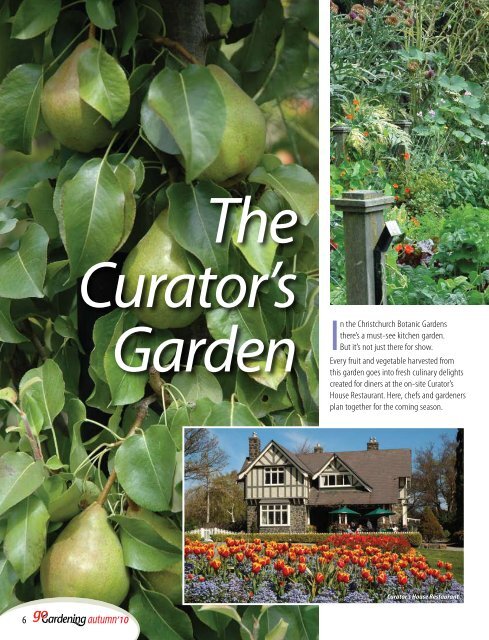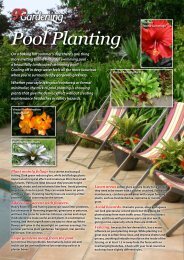You also want an ePaper? Increase the reach of your titles
YUMPU automatically turns print PDFs into web optimized ePapers that Google loves.
6 autumn’09 autumn’10<br />
6<br />
<strong>The</strong><br />
Curator’s<br />
<strong>Garden</strong> In<br />
the Christchurch Botanic <strong>Garden</strong>s<br />
there’s a must-see kitchen garden.<br />
But it’s not just there for show.<br />
Every fruit and vegetable harvested from<br />
this garden goes into fresh culinary delights<br />
created for diners at the on-site Curator’s<br />
House Restaurant. Here, chefs and gardeners<br />
plan together for the coming season.<br />
Curator’s House Restaurant
<strong>The</strong> charming heritage building that now houses the<br />
restaurant was once the private home of the curator<br />
of the Botanic <strong>Garden</strong>s. In 2000, it was developed by<br />
new owners, Javier and Jackie Garcia as a fine dining<br />
restaurant, and a feature of the Botanic <strong>Garden</strong>s.<br />
A garden for learning<br />
Initially set up by the Friends of the Botanic <strong>Garden</strong>s,<br />
the Curator’s House Restaurant garden continues as<br />
an educational facility under the guidance of Jackie<br />
Garcia’s father, Colin Knight and Section Curator,<br />
Louise Young.<br />
Packed full of useful ideas and inspiration, this<br />
beautiful demonstration garden is free to visit and<br />
entered directly from the Botanic <strong>Garden</strong>s. It’s a<br />
place to see sustainable gardening practices in<br />
action, including ideas on plant supports, fencing,<br />
paving, mulching, composting and which plants to<br />
grow in which season.<br />
Colin says “We’re always looking for something a<br />
bit different to use in the restaurant, so we like to<br />
try new varieties. Some work well but others don’t<br />
enjoy our climate. For instance some of the heritage<br />
tomatoes didn’t prosper for us. It’s all a matter of trial<br />
and error.” A noticeboard in the summer house keeps<br />
visitors up to date with the latest monthly plantings<br />
and gardening activities.<br />
Saving space<br />
One of the most intriguing things about this garden<br />
is just how many different edibles have been slotted<br />
into a relatively small area. <strong>The</strong> garden is divided<br />
into six distinct parts: an informal orchard, a potager<br />
containing veges and companion plants, a formal<br />
raised vegetable garden, a berry fruit area, a herb<br />
garden and a composting area. Plants are grown and<br />
trained in ways specifically designed to make the<br />
most of available land area. Dwarf peach trees and<br />
triple grafted apples produce excellent crops for the<br />
minimal space they occupy. Pear trees are trained<br />
on archways; apples are espaliered on fences; feijoas<br />
and Chilean guavas are grown as hedges. Cocktail<br />
kiwis and grapes scramble over a pergola and<br />
adorn fences.<br />
Ornamentally edible<br />
Such space saving methods also make a huge<br />
contribution towards the garden’s charm and<br />
ambiance. <strong>The</strong> garden has been designed to present<br />
the edibles as ornamentally as possible. <strong>The</strong> pear<br />
clad archways form a lovely central walk through<br />
the orchard area, while espaliered apples in full fruit<br />
add wonderful colour and texture. Peeping though<br />
boundary fences in autumn are masses of cheery<br />
red Chilean guavas. Citrus trees in large tubs provide<br />
Pumpkin<br />
‘Wee Be Little’<br />
<strong>The</strong> potager section of the<br />
demonstration garden.<br />
autumn’10<br />
7
NC006<br />
Grow<br />
great gardens,<br />
naturally<br />
<strong>The</strong> silverbeet<br />
absolutely took off<br />
and the strawberries<br />
were weeks ahead<br />
of the others.<br />
Colin Ardern,<br />
Conifer Grove <strong>Garden</strong>ing Club.<br />
New Plant Activator<br />
• Promote repair and increase defence<br />
against pests or disease<br />
• Grow better flavour, colour,<br />
fragrance and quality<br />
• 100% natural, certified for<br />
organic growing, safe to spray<br />
around children and pets<br />
WIN a bottle at stand CR5E<br />
Try it today<br />
Now in leading garden centres –<br />
see website for stockists.<br />
0800 247 247<br />
www.naturescurator.co.nz<br />
8 autumn’10<br />
amazing winter colour when in fruit. Raised vege<br />
plots with heavy wooden plant supports add a<br />
Victorian air. Even the potatoes have been given the<br />
decorative touch in their stack of brightly painted<br />
tyres. Flowers, most of them edible, add colour<br />
appeal while also acting as companion plants,<br />
helping ward off garden pests.<br />
Herbs, flowers and weeds!<br />
<strong>The</strong> restaurant also prides itself on innovative<br />
presentation. A beautiful selection of herbs and<br />
edible flowers adorn every dish and are therefore<br />
high priority on each season’s planting list -<br />
although many of these self-seed of their own<br />
accord. <strong>The</strong> odd weed also finds its way onto the<br />
menu, with dandelion, chickweed or wild sorrel<br />
likely to form part of your gourmet salad!<br />
Jackie and Javier are dedicated to running their<br />
business under the principles of environmental<br />
sustainability and the belief that the quality of the<br />
basic ingredients is fundamental in producing good,<br />
flavoursome and honest food.<br />
So if you’re lucky enough to be visiting the Ellerslie<br />
International Flower Show in Christchurch this<br />
March, pop down the road for a culinary treat - and<br />
an extra serving of edible gardening inspiration.<br />
For more about Ellerslie International Flower Show<br />
turn to page 10.<br />
FROM TOP TO BELOW:<br />
Pear archways create a lovely central walk.<br />
<strong>The</strong> formal vege garden demonstrates different<br />
methods of supporting plants.<br />
A pergola is the perfect support for fruiting vines.<br />
Chilean guavas make the perfect low growing hedge.
Autumn Harvest Tips<br />
Beans taste best when young and tender. Pick them daily.<br />
Beetroot tastes best when harvested small. Harvest evenly to<br />
allow space for remaining beets to grow.<br />
Peppers and chillies may be harvested at any stage. Chillies<br />
get hotter as they ripen from green to red. <strong>The</strong>y can be strung in<br />
‘ristras’ to slowly dry for winter use.<br />
Pumpkins are ripe if they sound hollow when tapped and<br />
when the vines start to die off.<br />
Tomatoes - a month before expected frost, cut off the top of<br />
the plant and remove new flower clusters to redirect energy into<br />
Beans<br />
the ripening of remaining fruit.<br />
Cucumbers should be picked regularly, daily if ready, to encourage more fruit.<br />
Main crop potatoes are ready for digging when the leaves have died down completely. Dig<br />
on a dry, windy day. Spread unwashed tubers in the shade to dry for a day or two in a shaded,<br />
airy place before storing.<br />
Apples and pears are ready to pick when they<br />
separate easily from the spur without breaking the stem<br />
and when fruit starts to drop.<br />
Figs are ripe when soft to the touch with full colour.<br />
Unripe figs exude white sap and will not ripen once picked.<br />
Dry ripe figs by laying them in the sun for 4 – 5 days.<br />
Apple cucumber<br />
Once dried, they’ll last 6 – 8 months.<br />
Companion planting<br />
Colin says of sweet peas “<strong>The</strong>y are one of<br />
my favourite companion plants. <strong>The</strong>y’re<br />
pretty, grow up any vertical support, are<br />
lovely for picking for the restaurant and<br />
they add nitrogen to the soil!”<br />
Edible Flowers<br />
<strong>The</strong> Curator’s House chefs’ favourite edible<br />
flowers include chives, nasturtiums, violas<br />
and borage.<br />
Sweet Pea<br />
Viola<br />
Nasturtium<br />
Chives<br />
Colin Knight checks the pumpkins in the Curator’s<br />
House demonstration garden.<br />
autumn’10 9




